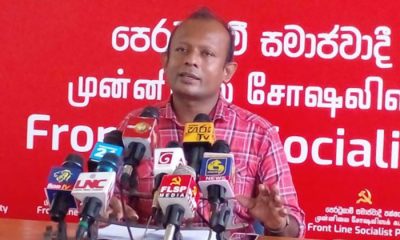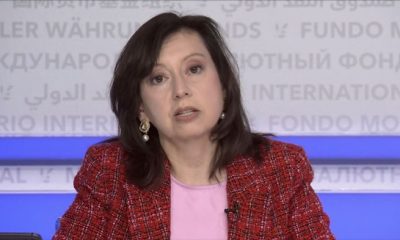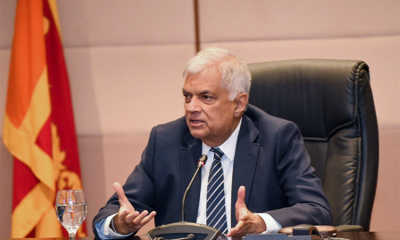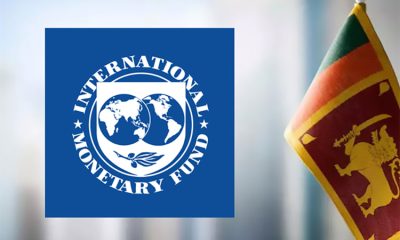Features
Is the IMF a Member of the UN Family?
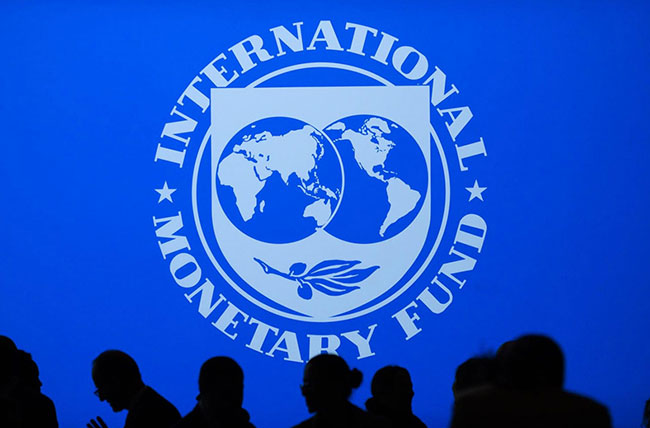
by Dr Sarala Fernando
The UN Secretary General seems to think so when he recently urged the Security Council and the Bretton Woods institutions to undertake reforms. Yet as the IMF programme unfolds in Sri Lanka one can see the divergence in the methods and objectives deployed by the IMF with its emphasis on domestic fiscal reforms and the UN which is advocating sustainable development, strengthening of health, education and protection of the environment and addressing global emergencies like climate change.
The mismatch is reflected in the growing chasm between the government and the public. The government had hoped that after Covid, Sinhala/Tamil New Year would be held in grand style this year, even providing funds to government institutions to organize events. Contrary to such expectations this year was marked with an absence of the usual cacophony of celebration. Instead of fireworks, the regular tv and radio counted down the auspicious times. The public was protesting the escalating cost of living as a result of new taxes, rupee depreciation causing food inflation, closing of enterprises and loss of jobs under the current IMF programme.
Reports galore on the increasing “misery” level with the deterioration marked among the most vulnerable under five-yearnold children, while women appear to be among the most affected whose plight, suicides, domestic violence, despair, are shown on live tv every night. Added to the woes it seems a sort of apathy has gripped the working people – that is those who have not been able to go abroad – seeming to prefer to voice their grievances and sink into depression rather than buckle down to work harder for more pay. Fortunately in Sri Lanka in time of any crisis, there is a huge network of humanitarian relief provided by the private sector, religious organizations, NGOs and concerned individuals which is making up for what the government cannot do.
People are asking now about the real cost/benefit of the IMF deal especially since it turned out that a substantial amount of the first tranche went back to the multilateral banks and bilateral lenders like India to meet outstanding debt repayments, as part of the IMF conditionality. In contrast, Bangladesh made the first positive move, offering to defer debt repayment on their $500 loan for another six months followed by India offering one year’s deffered repayment on their billion dollar loan.
The government argues that the IMF deal is a seal of approval opening the way for more assistance from multilateral banks and bilateral investors. But multilateral assistance has been slow to disburse in Sri Lanka such that when Covid hit, the World Bank just canceled their unutilized projects and redirected balances for the urgently required vaccines (in the haste, cancellation may have included expenditures already made by the government and not yet forwarded for reimbursement).Now the ADB has done the same, repurposed unutilized grants for emergency assistance of $350 million. For multilateral assistance to be well utilized there must be a strong domestic disbursement tracking system in place for timely reimbursement –has that been put into place and has the IMF provided necessary advice on that?
An early catastrophic consequence of the recourse to the IMF has been instead of strengthening human capital, there is an exodus of skilled workers and professionals for foreign employment leaving Sri Lanka’s flagship health and education system in dire straits, beset by strikes and shortages of equipment and essential drugs. Worse still, it is a blow to the national psyche where robust national health and education systems had given Sri Lanka its high social development standards, quoted as an example in early international indexes like the PQLI.
After the tsunami hit, our medical services responded immediately and prevented epidemics, hailed by WHO as exemplary. Now, young doctors well trained virtually free of charge in Sri Lanka, are leaving in droves attracted by study offers converted to work visas in overseas countries . Encouraged by the government release of foreign exchange for educational purposes, Sri Lanka’s students are facing a barrage of advertisements from foreign universities judging by the press advertisements and other inducements like work visas and permanent residence status upon graduation. There was even one advertisement recently by a foreign educational institution scouting for underage students with the added incentive of visas being provided for accompanying parents!!!
Has the IMF considered how focusing on revenue is disastrous for organizations like zoos which need not to boast about raising visitor revenue but rather on how they care for the animals in their charge? A similar situation exists for wild life parks and cultural triangle sites which are now encouraged to focus more on visitor revenue than on protecting the treasure in their charge. It is not only the family silver that is being put up for sale but even the wild animals are under threat.
The Agriculture Ministry has even entertained a proposal to export our wild monkeys for lab experiments and has been taken to court by a number of voluntary organizations, for this atrocious proposal. Now the Ministry of Agriculture is giving more firearms to farmers to kill monkeys, peacocks, wild boar etc claiming they are pests. What an example at this time of Wesak and Poson when the emphasis should be to highlight the Buddha’s message of compassion to the animals!
Having come out of two bloody youth insurrections, do we need to develop a gun culture in Sri Lanka or should we pursue UN sponsored programmes to collect and destroy small arms and light weapons? A domestic gun manufactory in Kadawatha has even started to advertise its wares in the local papers. Is there some connection between this new manufactory and the recent government initiative to promote gun distribution to farmers? Those concerned with national security would agree that the need of the hour after the end of the armed conflict is to reduce the numbers of small weapons in the hands of the public.
If culling is the only option, should not this be handed over to the military or police which is trained in the proper use of weapons? Compare our failed policies to the success of the wildlife campaigns in India under Prime Minister Modi with tiger numbers rising and parks well patrolled and conserved which has given the Indian Prime Minister excellent credentials internationally and a domestic political benefit as well, helping to draw the youth voters in India who are most interested today in nature and wild life protection.
The IMF with its focus on graphs and paper figures also needs to consider whether the value of tourism should be calculated in tourism arrival numbers and revenue forecasts or on goals of sustainability such as installation of renewable energy and recycling? Should unsolicited attractions like cable cars be entertained when unusually intense rains caused by climate change are causing the hillsides to collapse and what is required is more regulation to control construction in vulnerable areas? Forest conservators whose prime duty should be to protect the upper watershed from where all our major rivers derive, instead are being asked to sell off residual forests to raise revenue without a thought of the priority to increase forest cover to combat climate change as agreed under UN auspices.
As for bilateral assistance, sadly we hear from the press only about the controversial unsolicited projects, the return of the costly light rail system once abandoned due to protests from our transport specialists and a barge mounted nuclear power project apparently ignoring the perils of contamination from the worst maritime disaster experienced in Sri Lanka, Express Pearl. Following the IMF lead, the government focus is only on collection of compensation, yet what is needed is tightening of the regulations on carriage of hazardous materials as suggested by experts. Maritime zones around the country should be strictly protected and passing ships monitored for dropping plastic waste, excess oil etc in our waters as discussed under UN auspices.
Under the IMF raising revenue mantra, the government has lined up a list of failed SOE’s for sale or restructuring but has the IMF shared experience on how to do this with minimum social disruption? Why privatize strategic ventures like Sri Lanka Telecom which is a strong vibrant organization making profits and providing a good service? As a consequence its staff are demoralized and worrying about whether there is some deal already in the works for the new owner and whether that party will be interested in building the organization or just taking out its profits as quickly as possible.
Inevitably the discussions turn to queries of how geopolitics will play given the need to pay off the debt owed to India. It seems there are Indian companies lined up already to purchase these government assets, one such major player being the Adani group once brought to Sri Lanka as a “prestigious” investor subsequently smeared by legal challenges. The larger question that looms is the anxiety of the public over the growing Indian presence in our economy which if mishandled will become a major bilateral headache.
The government argument was that with the IMF nod of approval, it would open the path for new foreign investments, multilateral and bilateral. This approach has been contested by the public suggesting alternate domestic options ranging from moving to a knowledge economy including music and cinema exports, debt for nature swaps, bringing back “stolen” assets etc. In other words, their message to the government is that it should look inwards for domestic solutions instead of the old pattern of depending on foreign assistance and incurring more debt.
To restore its credibility, the government could begin by moving on the long overdue Ministry reorganization– finally let there be agreement on a fixed number of ministries with fixed locations which will facilitate public access. This reform has been stagnating since the time of Lakshman Jayakody who visited the Indian National Planning Commission for advice. A proposal worth considering is merging the Foreign Ministry with the Ministry of Trade, which has been accomplished in Australia for example quite successfully.
Consulting a respected Australian colleague, his comments were as follows: ” the Canberra amalgamation between foreign affairs and trade was so many decades ago that it now seems totally natural. At the time it involved a lot of pain and was divisive but time elapsed has more than demonstrated that it is a natural alliance and very sensible. Indeed much of the serious stuff and careers are now made on the trade side of the house. Our HC in Colombo would be able to obtain the various reviews etc but in short it’s been a huge success. We have two Cabinet ministers and two junior ministers to make the workload bearable.”
The Government can also do much more to cut down waste, requiring government ministries and agencies to give up rented buildings and declaring a moratorium on new building construction in favour of better usage of existing facilities. Seeing the shortage of beds for cancer patients in Anuradhapura main hospital and a building project which is stagnating, one wonders whether those emergency treatment centres opened for the Covid could not be repurposed to fill urgent health sector needs? Official reports suggest there are many unutilized building assets, empty small schools without teachers or students, unused small hospitals without doctors or proper equipment, which could be converted to support the morale of local communities.
As the IMF officers sit in far away offices and draw economic models on paper, they need to face the human predicament of those undertaking their reform programme and the need for conformity with UN expectations. The IMF is also learning and it is good therefore to note this time around that the visiting IMF team in Sri Lanka is meeting and facing questions from the public, the press, trade unions and opposition parties. Elsewhere in the world political leaders are pushing through unpopular measures and paying the price, like in France where as a result of pension reforms it seems President Macron is now unable to walk the streets without being accosted by protesters and heckled.
Little wonder that no elections are likely to be held in Sri Lanka in the near future and a mirage is being created by speculation over possible candidates for a quick Presidential poll. Fortunately for the IMF it has a charming Managing Director able to reach out to political leaders and with a friendly public image, a stark contrast to her stony faced officials!
(Sarala Fernando, retired from the Foreign Ministry as Additional Secretary and her last Ambassadorial appointment was as Permanent Representative to the UN and International Organizations in Geneva . Her Ph.D was on India-Sri Lanka relations and she writes now on foreign policy, public diplomacy and protection of heritage).
Features
The heart-friendly health minister

by Dr Gotabhya Ranasinghe
Senior Consultant Cardiologist
National Hospital Sri Lanka
When we sought a meeting with Hon Dr. Ramesh Pathirana, Minister of Health, he graciously cleared his busy schedule to accommodate us. Renowned for his attentive listening and deep understanding, Minister Pathirana is dedicated to advancing the health sector. His openness and transparency exemplify the qualities of an exemplary politician and minister.
Dr. Palitha Mahipala, the current Health Secretary, demonstrates both commendable enthusiasm and unwavering support. This combination of attributes makes him a highly compatible colleague for the esteemed Minister of Health.
Our discussion centered on a project that has been in the works for the past 30 years, one that no other minister had managed to advance.
Minister Pathirana, however, recognized the project’s significance and its potential to revolutionize care for heart patients.
The project involves the construction of a state-of-the-art facility at the premises of the National Hospital Colombo. The project’s location within the premises of the National Hospital underscores its importance and relevance to the healthcare infrastructure of the nation.
This facility will include a cardiology building and a tertiary care center, equipped with the latest technology to handle and treat all types of heart-related conditions and surgeries.
Securing funding was a major milestone for this initiative. Minister Pathirana successfully obtained approval for a $40 billion loan from the Asian Development Bank. With the funding in place, the foundation stone is scheduled to be laid in September this year, and construction will begin in January 2025.
This project guarantees a consistent and uninterrupted supply of stents and related medications for heart patients. As a result, patients will have timely access to essential medical supplies during their treatment and recovery. By securing these critical resources, the project aims to enhance patient outcomes, minimize treatment delays, and maintain the highest standards of cardiac care.
Upon its fruition, this monumental building will serve as a beacon of hope and healing, symbolizing the unwavering dedication to improving patient outcomes and fostering a healthier society.We anticipate a future marked by significant progress and positive outcomes in Sri Lanka’s cardiovascular treatment landscape within the foreseeable timeframe.
Features
A LOVING TRIBUTE TO JESUIT FR. ALOYSIUS PIERIS ON HIS 90th BIRTHDAY

by Fr. Emmanuel Fernando, OMI
Jesuit Fr. Aloysius Pieris (affectionately called Fr. Aloy) celebrated his 90th birthday on April 9, 2024 and I, as the editor of our Oblate Journal, THE MISSIONARY OBLATE had gone to press by that time. Immediately I decided to publish an article, appreciating the untiring selfless services he continues to offer for inter-Faith dialogue, the renewal of the Catholic Church, his concern for the poor and the suffering Sri Lankan masses and to me, the present writer.
It was in 1988, when I was appointed Director of the Oblate Scholastics at Ampitiya by the then Oblate Provincial Fr. Anselm Silva, that I came to know Fr. Aloy more closely. Knowing well his expertise in matters spiritual, theological, Indological and pastoral, and with the collaborative spirit of my companion-formators, our Oblate Scholastics were sent to Tulana, the Research and Encounter Centre, Kelaniya, of which he is the Founder-Director, for ‘exposure-programmes’ on matters spiritual, biblical, theological and pastoral. Some of these dimensions according to my view and that of my companion-formators, were not available at the National Seminary, Ampitiya.
Ever since that time, our Oblate formators/ accompaniers at the Oblate Scholasticate, Ampitiya , have continued to send our Oblate Scholastics to Tulana Centre for deepening their insights and convictions regarding matters needed to serve the people in today’s context. Fr. Aloy also had tried very enthusiastically with the Oblate team headed by Frs. Oswald Firth and Clement Waidyasekara to begin a Theologate, directed by the Religious Congregations in Sri Lanka, for the contextual formation/ accompaniment of their members. It should very well be a desired goal of the Leaders / Provincials of the Religious Congregations.
Besides being a formator/accompanier at the Oblate Scholasticate, I was entrusted also with the task of editing and publishing our Oblate journal, ‘The Missionary Oblate’. To maintain the quality of the journal I continue to depend on Fr. Aloy for his thought-provoking and stimulating articles on Biblical Spirituality, Biblical Theology and Ecclesiology. I am very grateful to him for his generous assistance. Of late, his writings on renewal of the Church, initiated by Pope St. John XX111 and continued by Pope Francis through the Synodal path, published in our Oblate journal, enable our readers to focus their attention also on the needed renewal in the Catholic Church in Sri Lanka. Fr. Aloy appreciated very much the Synodal path adopted by the Jesuit Pope Francis for the renewal of the Church, rooted very much on prayerful discernment. In my Religious and presbyteral life, Fr.Aloy continues to be my spiritual animator / guide and ongoing formator / acccompanier.
Fr. Aloysius Pieris, BA Hons (Lond), LPh (SHC, India), STL (PFT, Naples), PhD (SLU/VC), ThD (Tilburg), D.Ltt (KU), has been one of the eminent Asian theologians well recognized internationally and one who has lectured and held visiting chairs in many universities both in the West and in the East. Many members of Religious Congregations from Asian countries have benefited from his lectures and guidance in the East Asian Pastoral Institute (EAPI) in Manila, Philippines. He had been a Theologian consulted by the Federation of Asian Bishops’ Conferences for many years. During his professorship at the Gregorian University in Rome, he was called to be a member of a special group of advisers on other religions consulted by Pope Paul VI.
Fr. Aloy is the author of more than 30 books and well over 500 Research Papers. Some of his books and articles have been translated and published in several countries. Among those books, one can find the following: 1) The Genesis of an Asian Theology of Liberation (An Autobiographical Excursus on the Art of Theologising in Asia, 2) An Asian Theology of Liberation, 3) Providential Timeliness of Vatican 11 (a long-overdue halt to a scandalous millennium, 4) Give Vatican 11 a chance, 5) Leadership in the Church, 6) Relishing our faith in working for justice (Themes for study and discussion), 7) A Message meant mainly, not exclusively for Jesuits (Background information necessary for helping Francis renew the Church), 8) Lent in Lanka (Reflections and Resolutions, 9) Love meets wisdom (A Christian Experience of Buddhism, 10) Fire and Water 11) God’s Reign for God’s poor, 12) Our Unhiddden Agenda (How we Jesuits work, pray and form our men). He is also the Editor of two journals, Vagdevi, Journal of Religious Reflection and Dialogue, New Series.
Fr. Aloy has a BA in Pali and Sanskrit from the University of London and a Ph.D in Buddhist Philosophy from the University of Sri Lankan, Vidyodaya Campus. On Nov. 23, 2019, he was awarded the prestigious honorary Doctorate of Literature (D.Litt) by the Chancellor of the University of Kelaniya, the Most Venerable Welamitiyawe Dharmakirthi Sri Kusala Dhamma Thera.
Fr. Aloy continues to be a promoter of Gospel values and virtues. Justice as a constitutive dimension of love and social concern for the downtrodden masses are very much noted in his life and work. He had very much appreciated the commitment of the late Fr. Joseph (Joe) Fernando, the National Director of the Social and Economic Centre (SEDEC) for the poor.
In Sri Lanka, a few religious Congregations – the Good Shepherd Sisters, the Christian Brothers, the Marist Brothers and the Oblates – have invited him to animate their members especially during their Provincial Congresses, Chapters and International Conferences. The mainline Christian Churches also have sought his advice and followed his seminars. I, for one, regret very much, that the Sri Lankan authorities of the Catholic Church –today’s Hierarchy—- have not sought Fr.
Aloy’s expertise for the renewal of the Catholic Church in Sri Lanka and thus have not benefited from the immense store of wisdom and insight that he can offer to our local Church while the Sri Lankan bishops who governed the Catholic church in the immediate aftermath of the Second Vatican Council (Edmund Fernando OMI, Anthony de Saram, Leo Nanayakkara OSB, Frank Marcus Fernando, Paul Perera,) visited him and consulted him on many matters. Among the Tamil Bishops, Bishop Rayappu Joseph was keeping close contact with him and Bishop J. Deogupillai hosted him and his team visiting him after the horrible Black July massacre of Tamils.
Features
A fairy tale, success or debacle

Sri Lanka-Singapore Free Trade Agreement
By Gomi Senadhira
senadhiragomi@gmail.com
“You might tell fairy tales, but the progress of a country cannot be achieved through such narratives. A country cannot be developed by making false promises. The country moved backward because of the electoral promises made by political parties throughout time. We have witnessed that the ultimate result of this is the country becoming bankrupt. Unfortunately, many segments of the population have not come to realize this yet.” – President Ranil Wickremesinghe, 2024 Budget speech
Any Sri Lankan would agree with the above words of President Wickremesinghe on the false promises our politicians and officials make and the fairy tales they narrate which bankrupted this country. So, to understand this, let’s look at one such fairy tale with lots of false promises; Ranil Wickremesinghe’s greatest achievement in the area of international trade and investment promotion during the Yahapalana period, Sri Lanka-Singapore Free Trade Agreement (SLSFTA).
It is appropriate and timely to do it now as Finance Minister Wickremesinghe has just presented to parliament a bill on the National Policy on Economic Transformation which includes the establishment of an Office for International Trade and the Sri Lanka Institute of Economics and International Trade.
Was SLSFTA a “Cleverly negotiated Free Trade Agreement” as stated by the (former) Minister of Development Strategies and International Trade Malik Samarawickrama during the Parliamentary Debate on the SLSFTA in July 2018, or a colossal blunder covered up with lies, false promises, and fairy tales? After SLSFTA was signed there were a number of fairy tales published on this agreement by the Ministry of Development Strategies and International, Institute of Policy Studies, and others.
However, for this article, I would like to limit my comments to the speech by Minister Samarawickrama during the Parliamentary Debate, and the two most important areas in the agreement which were covered up with lies, fairy tales, and false promises, namely: revenue loss for Sri Lanka and Investment from Singapore. On the other important area, “Waste products dumping” I do not want to comment here as I have written extensively on the issue.
1. The revenue loss
During the Parliamentary Debate in July 2018, Minister Samarawickrama stated “…. let me reiterate that this FTA with Singapore has been very cleverly negotiated by us…. The liberalisation programme under this FTA has been carefully designed to have the least impact on domestic industry and revenue collection. We have included all revenue sensitive items in the negative list of items which will not be subject to removal of tariff. Therefore, 97.8% revenue from Customs duty is protected. Our tariff liberalisation will take place over a period of 12-15 years! In fact, the revenue earned through tariffs on goods imported from Singapore last year was Rs. 35 billion.
The revenue loss for over the next 15 years due to the FTA is only Rs. 733 million– which when annualised, on average, is just Rs. 51 million. That is just 0.14% per year! So anyone who claims the Singapore FTA causes revenue loss to the Government cannot do basic arithmetic! Mr. Speaker, in conclusion, I call on my fellow members of this House – don’t mislead the public with baseless criticism that is not grounded in facts. Don’t look at petty politics and use these issues for your own political survival.”
I was surprised to read the minister’s speech because an article published in January 2018 in “The Straits Times“, based on information released by the Singaporean Negotiators stated, “…. With the FTA, tariff savings for Singapore exports are estimated to hit $10 million annually“.
As the annual tariff savings (that is the revenue loss for Sri Lanka) calculated by the Singaporean Negotiators, Singaporean $ 10 million (Sri Lankan rupees 1,200 million in 2018) was way above the rupees’ 733 million revenue loss for 15 years estimated by the Sri Lankan negotiators, it was clear to any observer that one of the parties to the agreement had not done the basic arithmetic!
Six years later, according to a report published by “The Morning” newspaper, speaking at the Committee on Public Finance (COPF) on 7th May 2024, Mr Samarawickrama’s chief trade negotiator K.J. Weerasinghehad had admitted “…. that forecasted revenue loss for the Government of Sri Lanka through the Singapore FTA is Rs. 450 million in 2023 and Rs. 1.3 billion in 2024.”
If these numbers are correct, as tariff liberalisation under the SLSFTA has just started, we will pass Rs 2 billion very soon. Then, the question is how Sri Lanka’s trade negotiators made such a colossal blunder. Didn’t they do their basic arithmetic? If they didn’t know how to do basic arithmetic they should have at least done their basic readings. For example, the headline of the article published in The Straits Times in January 2018 was “Singapore, Sri Lanka sign FTA, annual savings of $10m expected”.
Anyway, as Sri Lanka’s chief negotiator reiterated at the COPF meeting that “…. since 99% of the tariffs in Singapore have zero rates of duty, Sri Lanka has agreed on 80% tariff liberalisation over a period of 15 years while expecting Singapore investments to address the imbalance in trade,” let’s turn towards investment.
Investment from Singapore
In July 2018, speaking during the Parliamentary Debate on the FTA this is what Minister Malik Samarawickrama stated on investment from Singapore, “Already, thanks to this FTA, in just the past two-and-a-half months since the agreement came into effect we have received a proposal from Singapore for investment amounting to $ 14.8 billion in an oil refinery for export of petroleum products. In addition, we have proposals for a steel manufacturing plant for exports ($ 1 billion investment), flour milling plant ($ 50 million), sugar refinery ($ 200 million). This adds up to more than $ 16.05 billion in the pipeline on these projects alone.
And all of these projects will create thousands of more jobs for our people. In principle approval has already been granted by the BOI and the investors are awaiting the release of land the environmental approvals to commence the project.
I request the Opposition and those with vested interests to change their narrow-minded thinking and join us to develop our country. We must always look at what is best for the whole community, not just the few who may oppose. We owe it to our people to courageously take decisions that will change their lives for the better.”
According to the media report I quoted earlier, speaking at the Committee on Public Finance (COPF) Chief Negotiator Weerasinghe has admitted that Sri Lanka was not happy with overall Singapore investments that have come in the past few years in return for the trade liberalisation under the Singapore-Sri Lanka Free Trade Agreement. He has added that between 2021 and 2023 the total investment from Singapore had been around $162 million!
What happened to those projects worth $16 billion negotiated, thanks to the SLSFTA, in just the two-and-a-half months after the agreement came into effect and approved by the BOI? I do not know about the steel manufacturing plant for exports ($ 1 billion investment), flour milling plant ($ 50 million) and sugar refinery ($ 200 million).
However, story of the multibillion-dollar investment in the Petroleum Refinery unfolded in a manner that would qualify it as the best fairy tale with false promises presented by our politicians and the officials, prior to 2019 elections.
Though many Sri Lankans got to know, through the media which repeatedly highlighted a plethora of issues surrounding the project and the questionable credentials of the Singaporean investor, the construction work on the Mirrijiwela Oil Refinery along with the cement factory began on the24th of March 2019 with a bang and Minister Ranil Wickremesinghe and his ministers along with the foreign and local dignitaries laid the foundation stones.
That was few months before the 2019 Presidential elections. Inaugurating the construction work Prime Minister Ranil Wickremesinghe said the projects will create thousands of job opportunities in the area and surrounding districts.
The oil refinery, which was to be built over 200 acres of land, with the capacity to refine 200,000 barrels of crude oil per day, was to generate US$7 billion of exports and create 1,500 direct and 3,000 indirect jobs. The construction of the refinery was to be completed in 44 months. Four years later, in August 2023 the Cabinet of Ministers approved the proposal presented by President Ranil Wickremesinghe to cancel the agreement with the investors of the refinery as the project has not been implemented! Can they explain to the country how much money was wasted to produce that fairy tale?
It is obvious that the President, ministers, and officials had made huge blunders and had deliberately misled the public and the parliament on the revenue loss and potential investment from SLSFTA with fairy tales and false promises.
As the president himself said, a country cannot be developed by making false promises or with fairy tales and these false promises and fairy tales had bankrupted the country. “Unfortunately, many segments of the population have not come to realize this yet”.
(The writer, a specialist and an activist on trade and development issues . )


